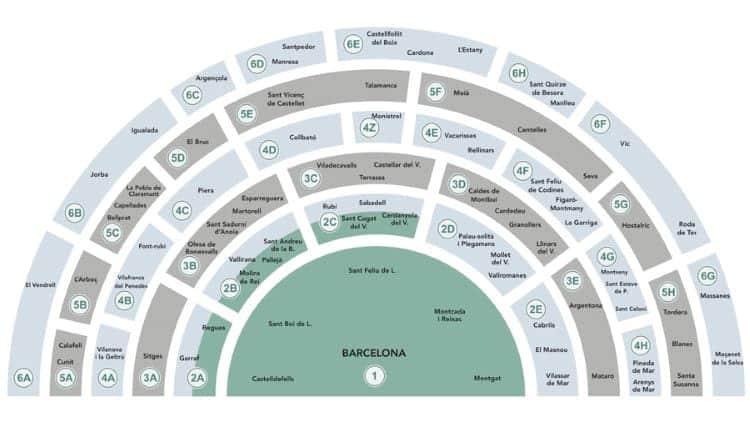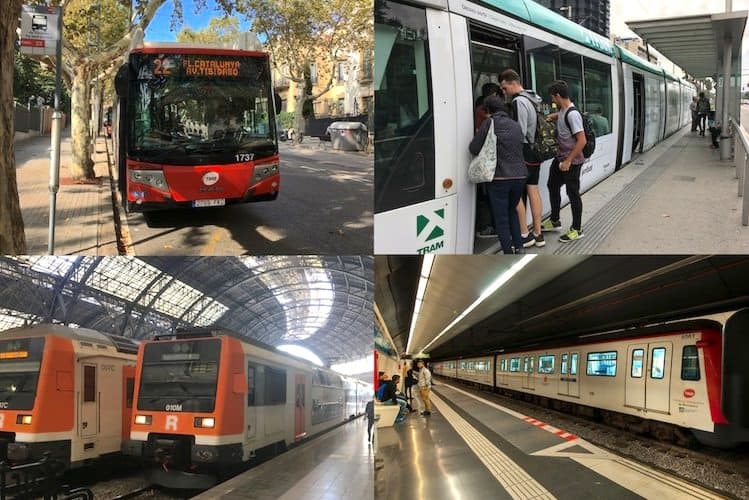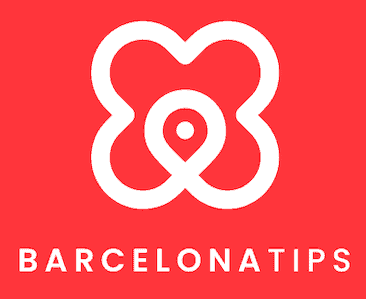Barcelona boasts an extensive public transport network, including a large metro system, two types of trains, city buses, and trams. The ticketing system is seamlessly integrated, allowing you to use multiple forms of transport with a single ticket, making it easy and convenient to get around the city.
Contents
- Zone map: Public transport Barcelona
- How does public transport work in Barcelona?
- Types of public transport in Barcelona
- Tickets and prices for public transport in Barcelona
- Getting to the airport by public transport
- Disabled accessibility
- Public transport with children
- Cycling on public transport in Barcelona
- Alternatives to travelling by public transport in Barcelona
Recommended: the Hola BCN! Travel Card
Enjoy unlimited travel on public transport for 2 to 5 days with the Hola BCN! Transport Card. If you order through this link, you will receive a 5% discount.
Public transport Barcelona: zone map

Barcelona is divided into 6 different transportation zones. Zone 1 covers the entire city, while Zones 2 to 6 extend to the suburbs and surrounding areas. The map above shows which cities are in each zone.
Please note: Traveling through multiple zones costs more than staying within a single zone. Most tourists will only need to travel within Zone 1, where main attractions like the Sagrada Família, Park Güell and Camp Nou can be found. Tickets for Zones 2 to 6 reach the outskirts of Barcelona and nearby towns such as Sitges (Zone 3) and Montserrat (Zone 4). The metro only operates within Zone 1.
How does public transport work in Barcelona?
Barcelona boasts an extensive and well-maintained public transport network that is affordable as well. The system includes metro, train, bus, and tram services, all integrated into a single ticketing system. With one ticket, you can conveniently travel on all these modes of transport.
Types of public transport in Barcelona
1. Metro (TMB)
Barcelona’s metro is fast, well-maintained, and safe. With the often busy traffic above ground, the underground metro is often the quickest way to get from A to B. Barcelona has eight metro lines, making it easy to reach almost all the city’s sights. The cable car from Paral·lel metro station up Montjuïc is also covered by the metro.
Regular Schedule:
| Day | Schedule |
| Monday to Thursday: | 5:00 AM to 12:00 AM (Midnight). |
| Friday: | 5:00 AM to 2:00 AM (Saturday). |
| Saturday: | 5:00 AM and open all night until Sunday night. |
| Sunday: | Open all day, until 12:00 AM (Midnight). |
| Day before a holiday: | 5:00 AM to 2:00 AM (Next day). |
| Holidays: | 5:00 AM to 12:00 AM (Midnight). |
The closing time means the time the last train leaves from each end of the metro line. Therefore, some stations close a bit later than the schedule listed here.
2. FGC trains
The Ferrocarrils de la Generalitat de Catalunya (FGC) is often mentioned alongside the TMB, Barcelona’s metro operator, as both companies manage the city’s metro network together. You can travel within Barcelona on FGC trains, which often resemble a metro, using the same ticket valid for tram, bus, and metro.
To reach destinations like Montserrat, Tibidabo, or Peu del Funicular (for the scenic Carretera de les Aigües cycling and walking route), you can also use the FGC. However, for out-of-town trips such as Montserrat, you will need a different, more expensive ticket that covers travel through two or more zones.
FGC’s main train stations for tourists in Barcelona are:
- Plaça Catalunya – In the heart of Barcelona, train (FGC and Rodalies) and metro connections meet.
- Plaça Espanya – Metro lines L1 and L3 also converge here
- Plaça Molina – In the uptown neighbourhood of Sant Gervasi
- Gràcia – On the Via Augusta
- Provença – In the centre of the Eixample neighbourhood
3. Rodalies regional trains (Renfe)
Within Barcelona itself, you will rarely need to use the Rodalies trains, as the metro and FGC provide easy access to most destinations. However, for day trips to places like Sitges, Castelldefels, Girona, or Figueres (home to the Dalí Museum), you’ll need to take the Rodalies, Catalonia’s regional train service. The Rodalies trains are also ideal for trips to Port Aventura amusement park or La Roca Village shopping center.
Additionally, the Rodalies is a convenient option for day trips to Barcelona from holiday spots such as Calella, Santa Susanna, Sant Pol de Mar, or Salou.
Rodalies’ main train stations for tourists in Barcelona are:
- Plaça Catalunya – Train connections and metro lines converge in the heart of Barcelona.
- Sants Estació – Barcelona’s largest train station.
- Passeig de Gràcia – The boulevard home to all the famous fashion houses, the works of Antoni Gaudí and other modernist architects.
- Estació de França – Close to the Barceloneta fishing quarter and beach, the trendy El Born district and Ciutadella city park.
- Arc de Triomf – Centrally located and close to Barcelona Nord bus station.
- El Clot-Aragó – This is where both lines of the metro (L1 and L2), and Rodalies (R1, R2, R11) converge.
4. Bus
Barcelona boasts an extensive network of city buses and connections, with over a thousand buses operating daily across more than eighty routes.
However, navigating this network can be challenging. Fortunately, the TMB transport app or Google Maps can simplify your journey by helping you find the best bus to take and its schedule.
City buses have the same pricing as the metro network and you can use the same ticket. Depending on the route, bus services typically start at 4:25 am and run until 11:00 pm, with varying frequencies.
In recent years, Barcelona introduced bus routes that travel horizontally (H), vertically (V), or diagonally (D), making it easier to identify the direction of each service.
5. Night bus (Nitbus)
If you need to return home at night, the night bus is the only form of public transport that operates every night of the week. Most services start between 10:40 pm and 11:40 pm, with the last rides between 5:00 am and 6:00 am. All buses depart from and return to Plaça Catalunya.
For fares, timetables, and a map of the different night bus lines, visit the transport company AMB’s website. The Nitbuses are operated by AMB, the great metropolitan transportation company and also cover all surrounding towns: Badalona, Castelldefels, Cervelló, Cornellà de Llobregat, El Prat de Llobregat, Esplugues de Llobregat, Gavà, Les Botigues de Sitges, l’Hospitalet de Llobregat, Molins de Rei, Montcada i Reixac, Montgat, Sant Adrià de Besòs, Sant Boi de Llobregat, Sant Climent de Llobregat, Sant Feliu de Llobregat, Sant Joan Despí, Sant Just Desvern, Santa Coloma de Cervelló, Santa Coloma de Gramenet, Tiana, Viladecans.
Additionally, the metro runs all night on Saturday-Sunday nights and until 2:00 am on Friday-Saturday nights.
6. Tram
The tram network in and around Barcelona consists of two networks, Trambaix and Trambesòs, and six lines (T1-T6). These all run through Barcelona, but only a small part of the city is connected to the tram network. Most tourists make little use of the tram as most destinations can be reached easily by metro. However, the tram network is currently being expanded, which will increase its coverage in the city.
The same prices apply to the tram as to the local metro network.
Tickets and prices for public transport in Barcelona
The price you pay for a ride on public transport in Barcelona depends on whether you stay within zone 1 and which ticket you use.
If you plan to use public transport extensively, it is advisable to buy a transport card for 2, 3, 4, or 5 days, such as the Hola BCN! Transport Card or the Barcelona Card.
For fewer trips, the T-Casual ticket is likely more suitable. This individual 10-ride ticket costs EUR 11.35 and can be used for tram, metro, bus, and train. Each trip on the T-Casual is valid for 1 hour and 15 minutes within one zone. Note that the T-Casual is valid for travel to Terminal 2 of the airport by train and on bus 46 to both terminals, but not for the blue Aerobus or the metro. There is a €5.50 surcharge if you take the metro to the airport.
Another way to explore Barcelona is with the Hop-on Hop-off bus. This open-top double-decker bus covers almost all the sights in Barcelona, allowing you to get on and off as often as you like.
For more detailed information on all public transport tickets types in Barcelona, click here.
Getting to the airport by public transport
There are several means of public transport to the airport. You can go by bus, train or metro. The easiest option is the Aerobus that goes directly to the airport from Plaça Catalunya or Plaça Espanya. Before leaving, always check which terminal you need to be at at the airport.
If you plan to travel to the airport by metro you will need a separate supplement. If you have a Barcelona Card or Hola BCN! Transport card, then you won’t need this supplement for the airport.
If you want to travel to Barcelona Airport by train, you can take the R2 Nord train. For this train, you won’t need a supplement on top of regular public transport tickets. Please note that this train only goes to Terminal 2. For Terminal 1, you will then have to take the free shuttle bus at the airport, but in terms of time, this is the fastest option.
Disabled accessibility public transport Barcelona
If you are visiting Barcelona with a wheelchair or have limited mobility, it’s important to know how accessible the city’s public transportation is for you. Fortunately, Barcelona is quite wheelchair-friendly, but there are some details you should be aware of.
General accessibility
Buses: All public buses in Barcelona are wheelchair accessible. Every bus is equipped with a designated space for wheelchairs, and the ramps make boarding and disembarking easy.
Metro: All metro’s arre accessible, but no all stations are. The stations that currently lack accessibility are:
- Line 1 (L1): Plaça de Sants, Espanya, Urquinaona, Clot
- Line 3 (L3): Espanya, Vallcarca
- Line 4 (L4): Maragall, Verdaguer, Urquinaona, Ciutadella-Vila Olímpica, Jaume I (under construction)
- Line 5 (L5): Virrei Amat, Maragall, Verdaguer, Plaça de Sants
- Additionally, there are certain transfers that are not accessible for wheelchair users: From L1 to L3 or FGC at Plaça Catalunya and From L2 or L4 to L3 or Renfe at Passeig de Gràcia.
Trains: Accessibility on Renfe’s trains and stations is still work in progress. While about half of the trains and stations are accessible, significant investments are being made to improve accessibility. The R1 line (Molins de Rei to Maçanet-Massanes) and the R2 Nord line (Airport to Maçanet) are well equipped for wheelchair users.
FGC Trains: FGC trains have excellent accessibility features and are generally very comfortable for wheelchair users.
Trams: Barcelona’s trams are fully accessible to disabled passengers.
Useful tips for wheelchair users
- Plan your routes: Before you travel, check the accessibility of your planned routes and stations. Use resources like the TMB website for up-to-date information on accessibility.
- Ask for help: If you need assistance, don’t hesitate to ask TMB staff for help at stations or on public transport.
- Use the TMB App: The TMB App offers information on routes, schedules, and accessibility features for public transportation.
Public transport with children
Children up to 3 years old can travel for free on public transport in Barcelona. For children aged 4 and above, a regular ticket is required. Public transport in Barcelona is very accessible for prams and buggies. The metro offers ample space for prams, and buses have designated areas specifically for them. Traveling with a baby is also convenient, as locals in Spain are generally polite and often offer their seats to parents with young children.
To ensure a comfortable journey, it is best to avoid traveling during rush hours (7am to 9am and 6pm to 8pm) when public transport can get busy.
Taking bicycles or e-scooters on public transport in Barcelona
Bicycles are allowed on metro and regional trains on Saturdays, Sundays, and public holidays, as well as every day during the months of July and August. On weekdays for the rest of the year, bicycles are permitted from 5:00 to 7:00, from 9:30 to 17:00, and from 20:30 until the stations close.
E-scooters are not allowed to be taken on to any means of public transportation in Barcelona, including trains, buses and metro.
Useful apps
Barcelona has 2 useful apps for traveling by public transport.
TMB App: This app provides useful information on all bus and metro services. And can be downloaded on Apple and Android. Through this app, you can easily search routes, nearest public transport, timetables, bus waiting times, maps. In short, everything you need to know about traveling by public transport.
Moovit: This app has all the information about the bus, metro, train and tram. In addition, Moovit has a handy directions function, letting you know exactly how far it is to walk, how long you have to wait and which stops you still have to pass.
Alternatives to travelling by public transport in Barcelona
To get from A to B in Barcelona, there are other transport options, taxi’s or bicycles for example. Taxi’s are pretty affordable. Bicycles are increasingly popular as well. There are various bicycle rental shops. You could also rent a scooter to get around. E-scooter rental is forbidden in Barcelona.


